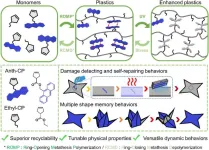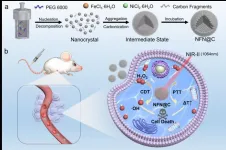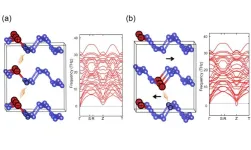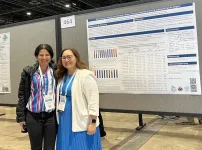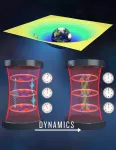Possible foundations of human intelligence observed for the first time
For the first time, it has been confirmed that, contrary to previous beliefs, individual neurons represent the concepts we learn, regardless of the context in which we encounter them
2025-03-06
(Press-News.org)
A study led by Dr. Rodrigo Quian Quiroga, group leader of the Neural Mechanisms of Perception and Memory Research Group at the Hospital del Mar Research Institute, has allowed scientists to observe for the first time how neurons in the human brain store memories independent of context in which they are acquired. Published in Cell Reports, the study confirms that neurons can distinguish objects or people regardless of their context, enabling the formation of higher and more abstract relationships, which constitutes the basis of human intelligence.
This is the first study to observe this neuronal behavior in humans. Until now, research conducted on animals had shown significant differences in the coding of concepts (such as a specific place, object, etc.) when the context changed. For example, neurons responded very differently if a rat found an object in one location versus another. As a result, it was believed that such memories were stored in different groups of neurons. The study led by Dr. Quian Quiroga has yielded "surprising responses" that contradict previous findings, as neuronal responses to a specific concept remain the same when the context changes, such as remembering having seen a person in different locations. "The basic principle of neuronal coding in humans is the opposite of what has been observed in other species, which has significant implications," notes Quian Quiroga.
Single Neuron Data
The study involved data from nine patients in Argentina and the United Kingdom with treatment for refractory epilepsy, who had electrodes implanted to monitor the activity of specific groups of neurons individually. This allowed researchers to obtain precise recordings of their responses, unlike previous human studies based on fMRI recording, which cannot differentiate individual neurons.
Patients were presented with two stories featuring the same person in different contexts, supported by images. Thanks to the monitoring of individual neurons while performing this task, researchers could observe which groups of neurons were activated and how they responded in the two stories. Specifically, they confirmed that if a neuron responded to a person’s image, the response remained the same in both stories. Furthermore, when patients recounted the story themselves, the same neurons were activated seconds before they referred to the protagonist, and also in the same way for both stories.
"Memories are stored in a much more abstract manner in humans compared to other animals. You can think of concepts or anything else in more abstract terms, independent of the context in which you learned them," explains Dr. Quian Quiroga, suggesting that this could be one of the "foundations of human intelligence." "This ability allows us to make much more abstract and complex associations and inferences than if we were forced to think of each concept within a specific, concrete context," he asserts. In other words, humans can decontextualize their memories to create more abstract thought.
Reference Article
Rey HG, Panagiotaropoulos TI, Gutierrez L, Chaure FJ, Nasimbera A, Cordisco S, Nishida F, Valentin A, Alarcon G, Richardson MP, Kochen S, Quian Quiroga R. Lack of context modulation in human single neuron responses in the medial temporal lobe. Cell Rep. 2025 Jan 28;44(1):115218. doi: 10.1016/j.celrep.2024.115218. Epub 2025 Jan 15. PMID: 39823228; PMCID: PMC11781864.
END
ELSE PRESS RELEASES FROM THIS DATE:
2025-03-06
A new paper in the Journal of Breast Imaging, published by Oxford University Press, indicates that breast cancer mortality rates have stopped declining in women older than age 74, and reconfirms that breast cancer mortality rates have stopped falling in women younger than age 40. This finding for older women is new.
Breast cancer is the second leading cause of cancer deaths in American women, with over 42,000 women dying of the disease in 2024. Before 1990, female breast cancer rates had been rising, and breast cancer mortality rates had been flat or increasing. Since 1990 there has been a steady decline ...
2025-03-06
Plastics, which are polymeric materials composed of long chains of small molecules called monomers, are widely used in everyday life and industry due to their lightweight, good strength and flexibility. However, with approximately 52 million tons of plastic waste generated annually, plastic pollution has become a major environmental concern. To address this issue, research efforts have focused on developing sustainable polymeric materials. Unfortunately, most materials developed so far suffer from complex synthesis processes or difficulties in separating them from other polymers during waste disposal.
To overcome these limitations, a research team led by Dr. Tae Ann Kim of the Convergence ...
2025-03-06
A type of Artificial Intelligence that mimics the functioning of the human brain could represent a powerful solution in automatically detecting wildfires, plummeting the time needed to mitigate their devastating effects, a new study finds.
The new technology uses an ‘Artificial Neural Networks’ model that combines satellite imaging technology with deep learning (a subset of Artificial Intelligence (AI) and machine learning).
Findings, published in the peer-reviewed International Journal of Remote Sensing, report a 93% success rate when training the model via a dataset ...
2025-03-06
Recently, a collaborative research team led by Professor WANG Hui and Professor ZHANG Xin from the Hefei Institutes of Physical Science of the Chinese Academy of Sciences, successfully developed a novel carbon-coated nickel ferrite (NFN@C) nanocatalyst with significant potential in cancer therapy.
The results have been published in Advanced Functional Materials.
Cancer therapy has always struggled with targeting tumor cells effectively while minimizing damage to healthy tissue. Traditional treatments like chemotherapy and radiation often have limited precision and serious side effects. This has led to increased ...
2025-03-06
New research by Curtin University has achieved a breakthrough in eco-friendly display technology, creating highly efficient and stable blue quantum dot LEDs (QLEDs) that could power the next generation of televisions, smartphones, VR headsets and energy-efficient lighting - without using toxic heavy metals.
Study author Associate Professor Guohua Jia from Curtin’s School of Molecular and Life Sciences said QLEDs are a futuristic display technology known for their superior brightness, colour accuracy, lifetime and energy efficiency compared to traditional LEDs. However, creating stable and efficient blue QLEDs without toxic materials ...
2025-03-06
Using first-principles calculations, a research group led by Prof. WANG Xianlong from the Hefei Institutes of Physical Science of the Chinese Academy of Sciences, found that phosphorus doping is an effective way to achieve high-energy polymeric nitrogen with black-phosphorus structure (BP-N) stable at ambient pressure.
The research results were published in Matter and Radiation at Extremes.
Cubic gauche nitrogen with diamond-like structure and BP-N with black phosphorus structure, represented by polymeric all-nitrogen materials, are a class of high-energy density materials composed entirely of N-N single bonds, but their samples ...
2025-03-06
Children exposed to their mother’s cannabis use during pregnancy and after birth are three times more likely to develop behavioural problems, new Curtin University research has found.
Published in Psychiatry Research, the study analysed data from more than 222,600 Australian mothers and children, revealing maternal cannabis use disorder (CUD) during pregnancy and the postnatal period significantly increased the risk of childhood disruptive behavioural disorders.
Lead researcher Abay Tadesse, from Curtin’s School of Population ...
2025-03-06
Children ages two to eight years across 11 Pacific jurisdictions (Alaska, American Samoa, Commonwealth of the Northern Mariana Islands, Federated States of Micronesia, Guam, Hawai‘i, Marshall Islands, and Palau) are not meeting daily recommended intakes for key micronutrients, either consuming too much or too little. That discovery was published recently in a study led by scientists at the University of Hawai‘i (UH) at Mānoa. The research team also found associations between children’s micronutrient intake, obesity, and presence of acanthosis nigricans, a skin condition that is ...
2025-03-06
An international team of scientists developed augmented reality glasses with technology to receive images beamed from a projector, to resolve some of the existing limitations of such glasses, such as their weight and bulk. The team’s research is being presented at the IEEE VR conference in Saint-Malo, France, in March 2025.
Augmented reality (AR) technology, which overlays digital information and virtual objects on an image of the real world viewed through a device’s viewfinder or electronic display, has gained traction in recent years with popular gaming apps like Pokémon Go, and real-world applications in areas including education, manufacturing, ...
2025-03-06
For over a century, physicists have grappled with one of the most profound questions in science: How do the rules of quantum mechanics, which govern the smallest particles, fit with the laws of general relativity, which describe the universe on the largest scales?
The optical lattice clock, one of the most precise timekeeping devices, is becoming a powerful tool used to tackle this great challenge. Within an optical lattice clock, atoms are trapped in a “lattice” potential formed by laser beams and are manipulated with precise control of quantum coherence and interactions governed by quantum mechanics. Simultaneously, ...
LAST 30 PRESS RELEASES:
[Press-News.org] Possible foundations of human intelligence observed for the first time
For the first time, it has been confirmed that, contrary to previous beliefs, individual neurons represent the concepts we learn, regardless of the context in which we encounter them
